Capped Bust Half Dollar (1807-1839)
Capped Bust Half Dollar Die Varieties, Part I (1807-1821)
In mid-1807 the Draped Bust Half Dollar was succeeded by the Capped Bust of Liberty that featured a reverse known to collectors whimsically as the “sandwich board” eagle. Though modified several times over the next thirty years, this same basic design was struck every year but 1816 and was employed through 1836, when the lettered edge half dollar gave way to the reeded edge style. Subsequent half dollar types were largely standardized and feature only minor varieties. This section covers Overton die varieties for Capped Bust Half Dollars from 1807 through 1821. Later dates are described in the subsequent two sections.
Half dollar die varieties from 1807-1836 are quite popular with variety specialists. Since many of the design elements required to complete a die were punched into it by hand, each die is readily distinguishable. Half dollars are especially popular with collectors, since so many have survived at or near the mint state level. This was due to their relatively large mintages, combined with the fact that they often remained idle in bank vaults as a hard-money backing for paper currency.
NGC will assign Overton (O) numbers to all half dollars die varieties from 1807 through 1821. In Overton’s system, the first die variety listed is given the number 101, and each date begins anew with this number, followed by O-102, O-103, etc. Later die states within a single die pairing use suffix letters. For example, 1808 variety 107 is identified successively as O-107 and O-107a.
A more recent publication that offers a “quick-finder” attribution guide for Overton varieties is the book by Glenn R. Petersen. Beginners will find this later effort quite useful. Also entertaining and useful is the Edgar Souders book, which imparts the sheer joy of collecting these handsome and varied issues. Mr. Souders also penned a quick-finder guide to some of the scarcer varieties.
Capped Bust Half Dollar Die Varieties, Part II (1822-1828)
This section covers Overton die varieties for Capped Bust Half Dollars from 1822 through 1828. Earlier dates are described in the previous section, and the subsequent section discusses the later dates of the series.
The Capped Bust Half Dollars of 1807-1836 are quite popular with both die variety specialists and date collectors. Among early USA coins, they are easily the half dollars most widely collected by die varieties. Since many of the design elements required to complete a die were punched into it by hand, each die is readily distinguishable. The Capped Bust type is especially popular with collectors who attempt to build sets by Overton die variety number, the standard reference guide to this series.
Capped Bust Half Dollar Die Varieties, Part III (1829-1836)
This section covers later date Capped Bust Half Dollars from 1829 to 1836. Earlier dates are described in the previous two sections.
The Capped Bust Half Dollars of 1807-1836 are quite popular with both die variety specialists and date collectors. Among early USA coins, they are easily the ones most widely collected by die varieties. Since many of the design elements required to complete a die were punched into it by hand, each die is readily distinguishable, and well catalogued in the standard reference to the series by Al Overton. The Capped Bust half dollar type is especially popular with collectors, since so many have survived at or near the mint state level. This was due to their relatively large mintages, combined with the fact that they often remained idle in bank vaults as a hard-money backing for paper currency.
NGC will assign Overton (O) numbers to all half dollar die varieties from 1829 through 1836. Die varieties in Overton’s system are given the number 101 for the first die variety listed, and each date begins anew with this number, followed by O-102, O-103, etc. Later die states within a single die pairing use suffix letters. For example, 1834 half dollar die variety 115 is identified successively as O-115 and O-115a.
A more recent publication that offers a “quick-finder” attribution guide for Overton half dollar die varieties is the book by Glenn R. Petersen. Beginners will find this later effort quite useful. Also entertaining and useful is the Edgar Souders book, which imparts the sheer joy of collecting these handsome and varied issues. Mr. Souders also penned a quick-finder guide to some of the scarcer half dollar die varieties.
Showing all 7 results
-
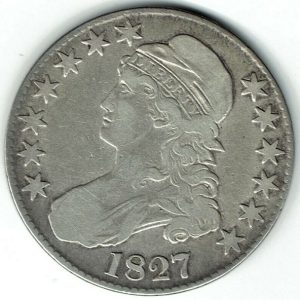
1827 Capped Bust square base 2 variety Half Dollar
$149.99 Add to cart -
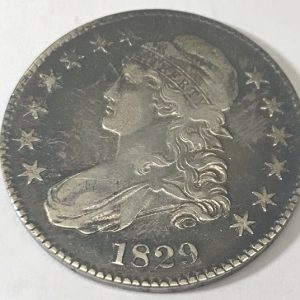
1829 CAPPED BUST HALF DOLLAR Small Letters
$189.99 Add to cart -
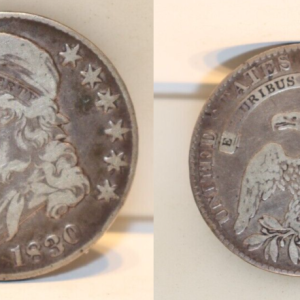
1830 Small 0 US Bust Silver Half Dollar $1 Fine +
$179.99 Add to cart -
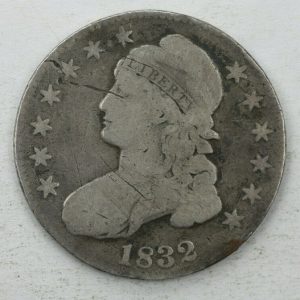
1832 Capped Silver Bust Half Dollar
$69.99 Add to cart -

1833 BUST HALF DOLLAR OLD USA MONEY SILVER.
$112.99 Add to cart -
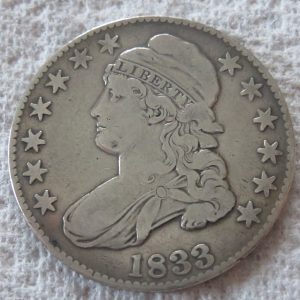
1833 CAPPED BUST HALF DOLLAR
$159.00 Add to cart -
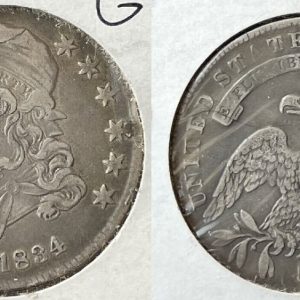
1834 Capped Bust Half Dollar, Early Date Silver. Beautiful US Coin
$149.99 Add to cart
